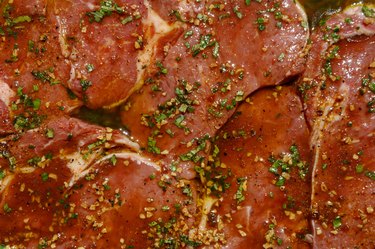
The development of vacuum-sealed packaging removes oxygen from around meat, disabling aerobic bacteria which need oxygen to decompose the beef. Depending on the quality of packaging, transportation and refrigeration of beef products, they can have a shelf life of several months, but the freshest cuts can be determined by a few factors, such as color, odor and texture.
Expiration Date
Video of the Day
As with all perishable items, the Food and Drug Administration, or FDA, requires a product dating system like a Use By or Sell By date printed on the packaging. Check the date on this package when shopping for beef. The FDA recommends consuming vacuum-sealed fresh beef no more than three to five days after purchasing.
Video of the Day
Liquid
Observe the color of the beef -- look for a rich red, almost maroon color. Pink fluid pooled in the bottom of the package does not indicate spoilage -- it indicates freshness. However, excess pooled moisture -- if it covers the meat by more than 1/4 inch -- is the result of faulty refrigeration.
Color
Beef cuts have a natural deep red, almost ruby color. When sealed in a vacuum package free of oxygen, beef exudes a much darker, almost purplish color, which should not be confused with spoilage. Once fresh beef is exposed to oxygen it will begin to display its natural color after about 15 minutes. When beef appears brownish around the edges, this indicates air and possible bacteria exposure: The first signs of spoilage.
Odor
Packaged beef may have an odor when first removed from the package -- this is normal. It dissipates in about 30 minutes; however, if the odor does not dissipate after 30 minutes, it indicates protein degradation.